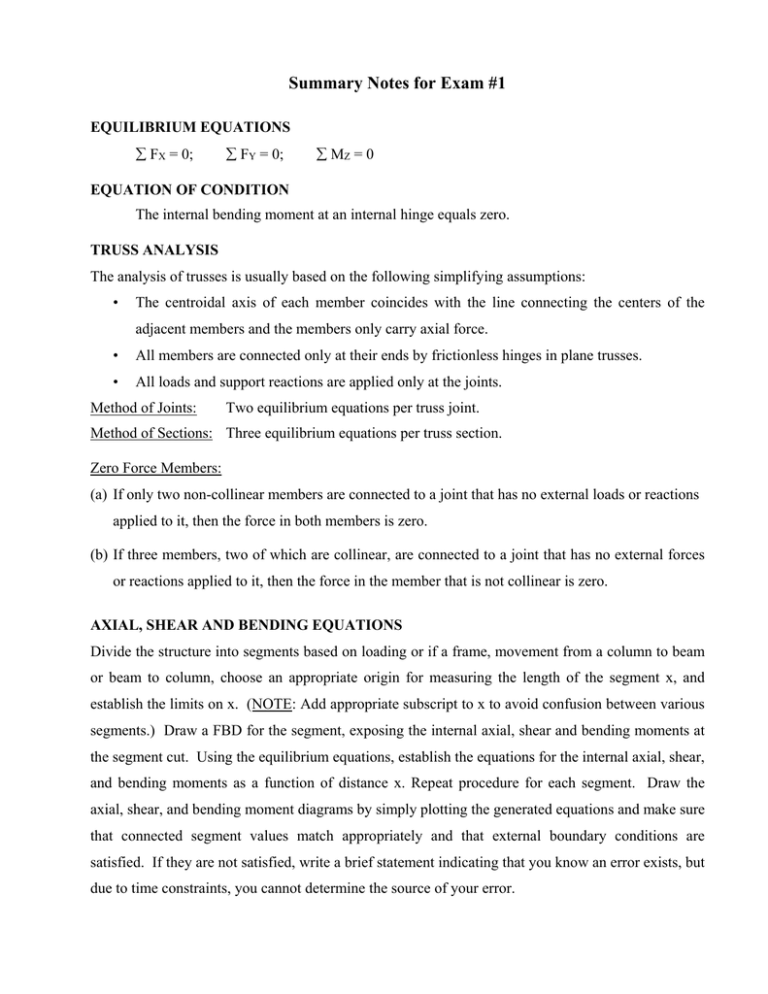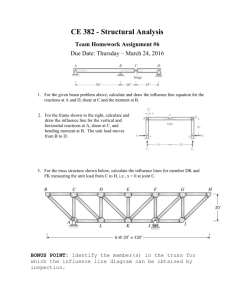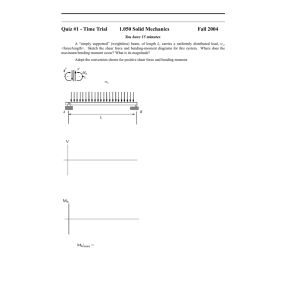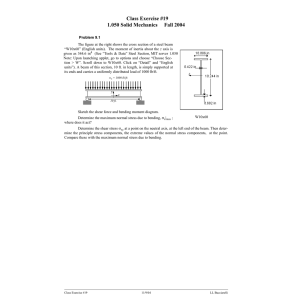Summary Notes for Exam #1
advertisement

Summary Notes for Exam #1 EQUILIBRIUM EQUATIONS FX = 0; FY = 0; MZ = 0 EQUATION OF CONDITION The internal bending moment at an internal hinge equals zero. TRUSS ANALYSIS The analysis of trusses is usually based on the following simplifying assumptions: • The centroidal axis of each member coincides with the line connecting the centers of the adjacent members and the members only carry axial force. • All members are connected only at their ends by frictionless hinges in plane trusses. • All loads and support reactions are applied only at the joints. Method of Joints: Two equilibrium equations per truss joint. Method of Sections: Three equilibrium equations per truss section. Zero Force Members: (a) If only two non-collinear members are connected to a joint that has no external loads or reactions applied to it, then the force in both members is zero. (b) If three members, two of which are collinear, are connected to a joint that has no external forces or reactions applied to it, then the force in the member that is not collinear is zero. AXIAL, SHEAR AND BENDING EQUATIONS Divide the structure into segments based on loading or if a frame, movement from a column to beam or beam to column, choose an appropriate origin for measuring the length of the segment x, and establish the limits on x. (NOTE: Add appropriate subscript to x to avoid confusion between various segments.) Draw a FBD for the segment, exposing the internal axial, shear and bending moments at the segment cut. Using the equilibrium equations, establish the equations for the internal axial, shear, and bending moments as a function of distance x. Repeat procedure for each segment. Draw the axial, shear, and bending moment diagrams by simply plotting the generated equations and make sure that connected segment values match appropriately and that external boundary conditions are satisfied. If they are not satisfied, write a brief statement indicating that you know an error exists, but due to time constraints, you cannot determine the source of your error. DISPLACEMENT CALCULATIONS We studied the principle of virtual forces for calculating the structure displacements at a single point. This principle states that the external virtual work ( WV or WVext ) equals the internal virtual strain energy or internal virtual work ( U V or WVint ); i.e. WV = U V based on the conservation of energy principle. In generating the external and internal virtual works, a unit virtual force or couple is applied at the desired displacement or rotation point in the assumed direction of the displacement or rotation. These calculations can be expressed as 1 = [FVi (FiLi)/EAi] TRUSS ANALYSIS i 1= [ ( MVi (M /EI )) dx] BEAM OR FRAME ANALYSIS [ ( MVi (M /EI )) dx] BEAM OR FRAME ANALYSIS i i i 1= i i i in which = desired displacement; = desired rotation; FVi = virtual axial force for member i due to a unit virtual force at ; Fi = real axial force for member i; M Vi = virtual moment equation of segment i due to unit virtual force at ; M Vi = virtual moment equation of segment i due to a unit virtual couple at ; Mi = real bending moment equation in segment i due to the external loading; = summation over the members or segments; A = cross sectional area; I = moment of inertia; L = member length; and E = elastic modulus. Remember, only one real analysis is required per structure and this is performed first to establish L for each truss member or the real internal bending moment equations M, but a separate virtual load analysis must be conducted for the structure for each desired displacement or rotation without the applied loading. Problems on Exam 1 will be similar to the homework problems. There will be three problems: truss, beam and frame. Each problem will ask multiple questions. NOTE: Metrics for the class requires that you demonstrate knowledge of the theory as well as ability with the equations.


